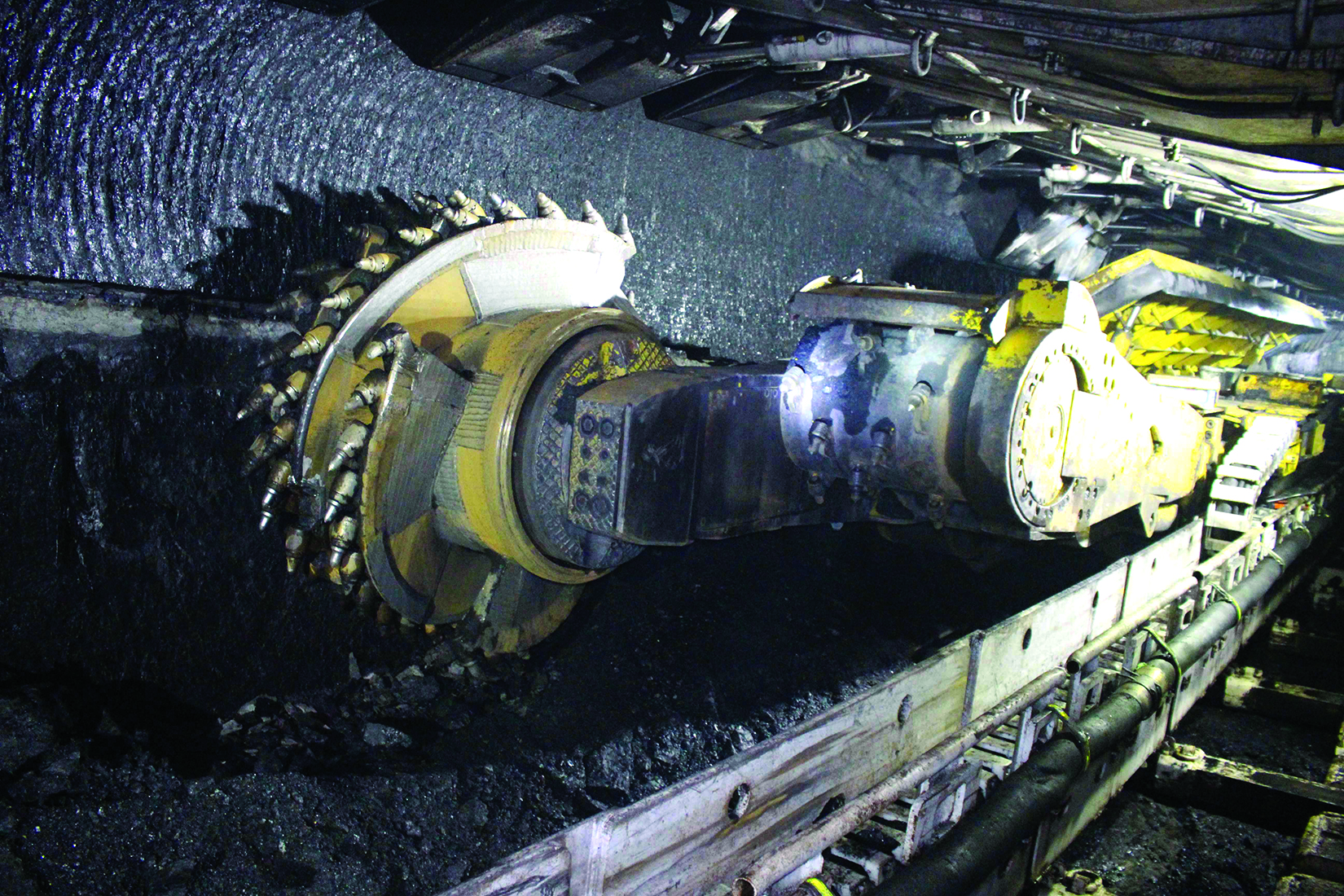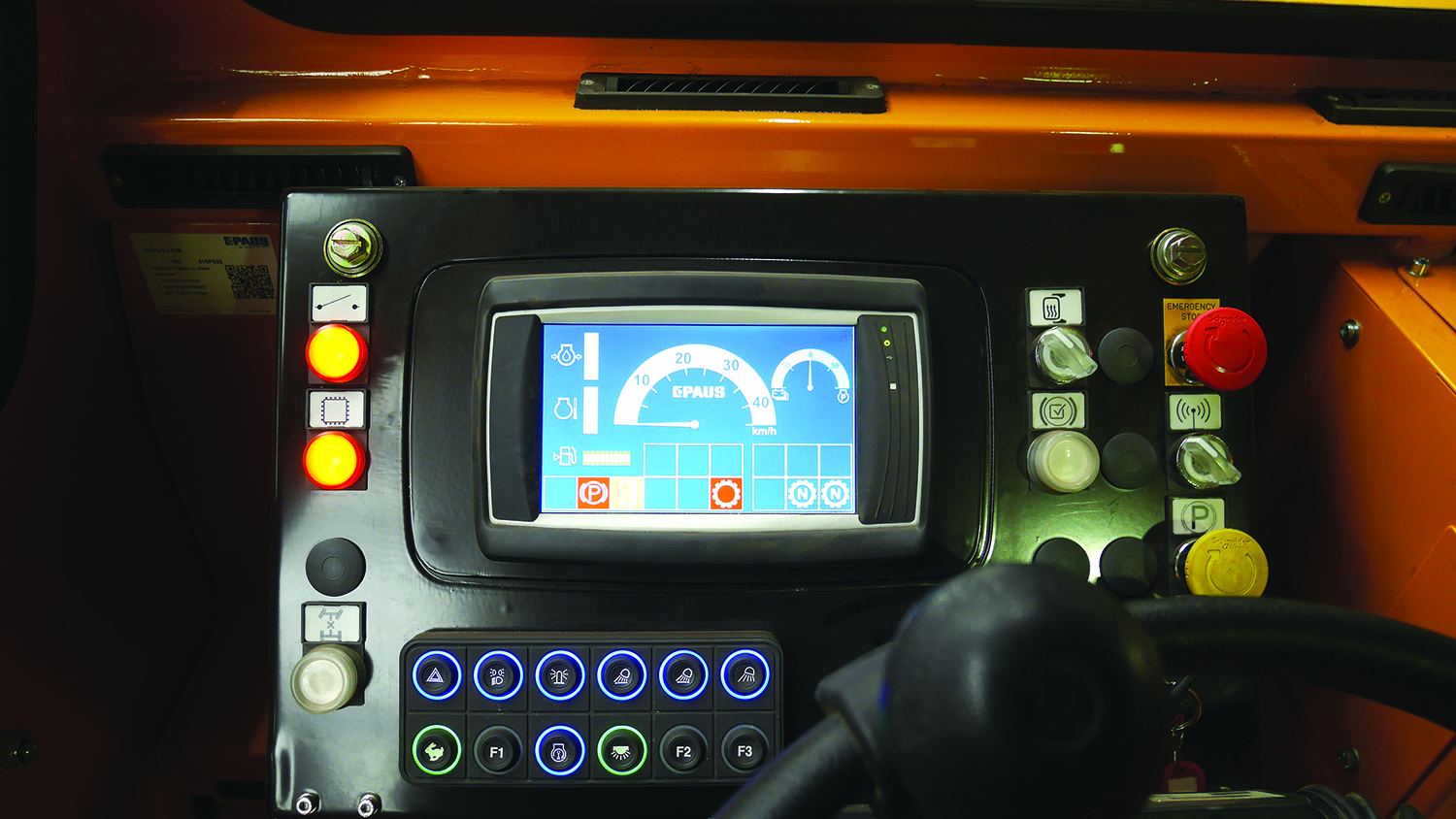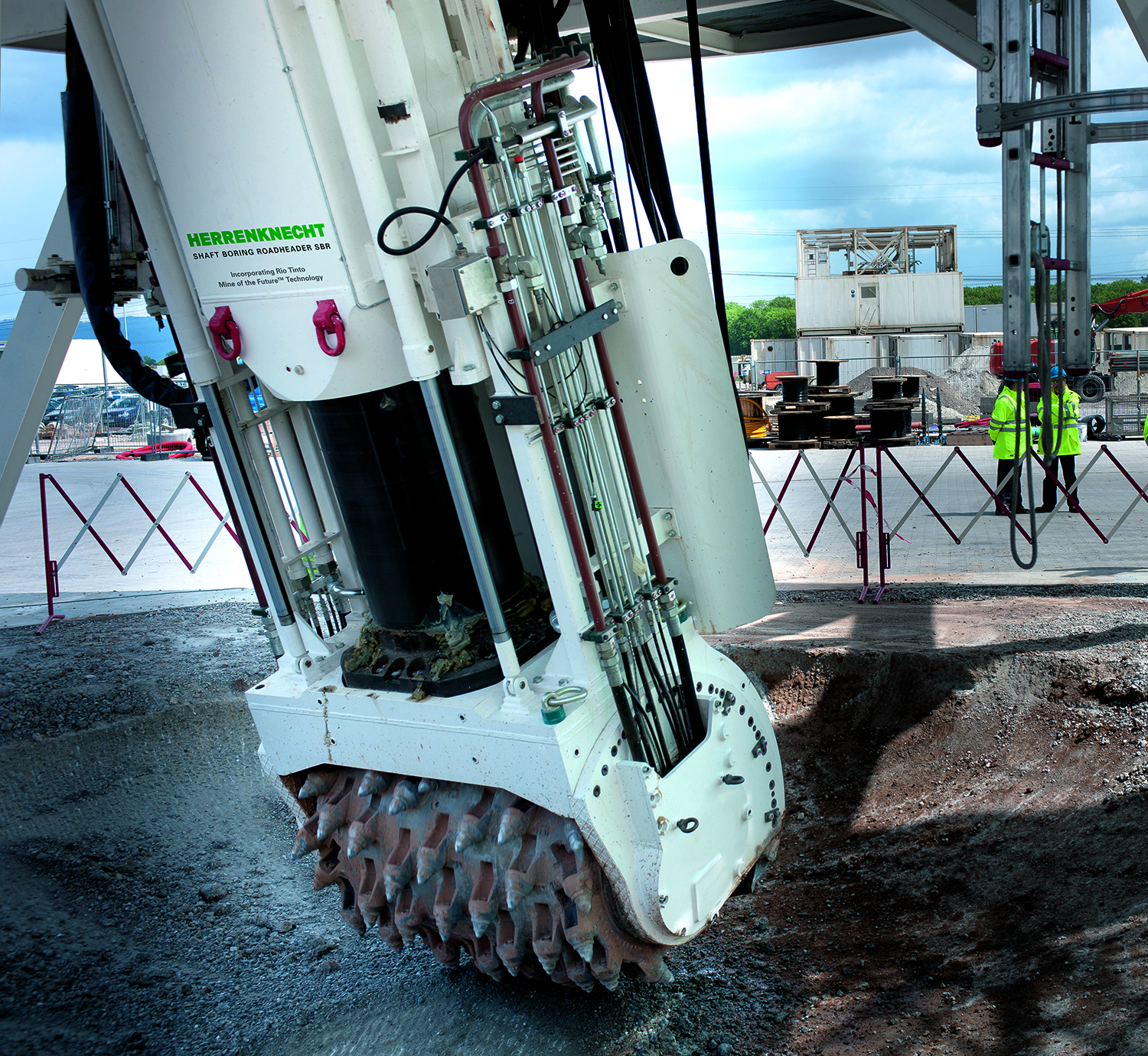New tools help underground mines operate more safely and efficiently
Germany may have closed its last hard coal mine, the 150-year-old Prosper Haniel operation, in 2018. However, this has not hindered the country’s equipment producers whose underground wares are now mainly destined for operations abroad. German manufacturers are world-renowned for their high-quality products and engineering prowess, which, as you will see below, has stood vendors in good stead over the past year at some of the world’s largest mining operations.
Eickhoff Opens New Service Centers and Delivers Automation
Eickhoff Bergbautechnik is a market leader in the supply of longwall shearer loaders for underground operations worldwide. For several decades, the company has been at the cutting edge of system design and application.
While the mechanical setup of these machines is constantly evolving, the team describes the development of electrical and digital systems for these applications as a “revolutionary.” Eickhoff said the overall trend in the mining industry toward automation defines the specification of both today, and future generations of underground mining equipment.
The first sensor and software-guided, fully automated longwalls are already in operation and more are set to be delivered this year. These, coupled with the use of sensors and analysis software that allow on-board diagnosis and predictive maintenance, are enabling safer operations with fewer people at the face, better performance at lower costs, and the optimization of service and maintenance activities.
The global fleet of Eickhoff shearer loaders and continuous miners is growing fast. The company attributes this to the exceptional performance and recent production records its machines have set, as well as its reputation for service and support, backed by quality German engineering.
To support its machine population in the field, Eickhoff has lifecycle service centers located in all major mining markets. In 2019, the company strengthened its setup by relocating three of its subsidiaries — Australia, Poland and Russia — into brand new, purpose-built facilities equipped for shearer loader and continuous miner maintenance, overhauls and compatibility setups.
The purpose-designed and constructed “Life Cycle Management Centre” for Eickhoff Australia Pty (EAP) was opened in March 2019 and is equipped with 120-tonne lifting capacity equipment; enough to handle the largest complete machine within the Australian Eickhoff shearer loader fleet. The site also has a 1-MW-load test facility to enable major unit testing in line with parent company test standards, and a 65-meter test track for full function testing capabilities.
First Eickhoff SL900 Heads to Moranbah
Eickhoff has already completed one major delivery in 2020, with another on the horizon. The first Eickhoff CM45 continuous miner for the Indian market arrived at the PVK5 mine at the end of February and production is scheduled to start in April.
Shortly after, the first Eickhoff SL900 shearer for Australia will be delivered to Anglo American’s Moranbah mine in Queensland. Eickhoff has a long-standing relationship with Anglo American in Australia: the companies have worked together for many years at the Grasstree longwall mine, which operated an Eickhoff SL 300 shearer before upgrading recently to the SL 750 equipped for autonomous operation.
The SL 900 for Moranbah will be dispatched from Bochum in March and is scheduled to arrive in Australia at the end of May. Reassembly and function testing of the components will be undertaken at the new EAP Life Cycle Management Centre where mine site personnel will have the opportunity to view the machine and partake in training prior to delivery of the machine to the compatibility site in August. Following this, the machine will be sent to the mine site for installation and operation.
The soon-to-be-delivered Eickhoff SL 900 shearer loader is the big brother to the Eickhoff SL 750 operating at the Australian Grasstree mine. It is specified to the highest level of today’s technologies for remote autonomous longwall operation in mid- to high-seam sections with high production levels. The SL 900 has an unmatched track record and it holds the global production record for underground coal mining, reached in August 2018 with 1.627 million tonnes per month at SUEK’s Yalevsky mine in Russia.
Paus’ MinCa 5.1 E: Ready for Action
The past 12 months have been exceptionally busy for underground vehicle specialist Hermann Paus Maschinenfabrik GmbH. Like many leading German mining equipment manufacturers, the company is family owned. Managing director, Franz-Josef Paus, discussed some of the most important developments from 2019.
“Given the situation in the world markets with all its uncertainties, we are satisfied with the year passed,” he said. “We have achieved all sales targets, both in total numbers and in regional breakdown, and we are confident that the business will stay as is or even slightly get better.

The MinCa 5.1 E electric-drive people carrier debuted at the bauma 2019 tradeshow in Munich. (Photo: Paus)
“After the boom years about 8-10 years ago, we now see that the time has come for equipment to be replaced soon in all markets. Especially since the gold price is getting higher, this should help gold mines to invest. Many of these are operated as narrow vein mines — our range of specialized small underground machines such as the PFL loader or the Minca 5.1 are ideal for this purpose. We will be presenting our new scaler at the MINExpo in Las Vegas in September.”
Paus’ latest product launch was the electrically driven MinCa 5.1 E passenger vehicle, which had its debut at bauma 2019 in Munich. The company has two universal vehicles in its portfolio — the MinCa 5.1 and MinCa 18A — that can be individually configured to suit mine transport requirements. The MinCa 5.1 E is based on the MinCa 5.1, and Paus’ stated that the new model can meet the needs of tomorrow’s deep underground mines. The MinCa 5.1 E produces no exhaust emissions, thus reducing the burden on the ventilation equipment — and at the same time improving the conditions for the personnel who work underground.
The MinCa 5.1 E measures 4 m x 1.95 m and can carry a payload of approximately 1.2 t. These statistics make it well-suited for use in narrow vein mining or tunnel construction. Also, a 90° turn can be driven with a roadway width of only 2.9 m. With the electric drive, no shifting operations are necessary, and the vehicle can reach a speed of up to 30 km/h on straight tracks.
The MinCa 5.1 E can be equipped as a passenger transporter for up to five people with space for equipment or as a repair vehicle. Special combinations of superstructures are also possible on request.
The new MinCa 5.1 E is an addition to the MinCa 5.1 family. It features nickel-managanese-cobalt-oxide (NMC) batteries and, with the appropriate charging technology, it can be charged to 80% of its capacity in just half an hour. The battery pack is located at the rear of the vehicle. However, the capacity “under the hood” can be extended with a further 50 kWh. This gives mines the opportunity to increase the MinCa 5.1 E to 100-kWh capacity, which can run an eight-hour shift even under the toughest conditions. The 35% gradeability is almost unmatched. With up to 25 km/h, you can drive quickly from place to place. The speed of 20 km/h on ramps with 30% gradient is impressive. Due to the high torque, ramps up to 35% are no problem. With the optionally available onboard charger, it is also possible to charge at any eight-phase AC connection.
Like all mining vehicles from Paus, the MinCa 5.1 E was specifically designed and built for use in underground mining. The thickness of the materials used are specially dimensioned for underground operation to ensure a long working life. Safety aspects such as the ROPS/FOPS driver’s cab are a given. Even the planetary rigid axles cannot be compared with adapted road vehicles — they are much more durable. The MinCa 5.1 E also features a four-wheel drive system to handle rough roads and inclined ramps up to 45°.
“The MinCa 5.1 E has successfully passed all trials on and underground and is ready to go,” Franz-Josef Paus said proudly. “Next up is the MinCa 18 and an LHD loader series.
“Just before the end of 2019, we commissioned a bigger batch of MinCa 5.1s to our long-term customer Norilsk Nickel. After trials with some pilot units earlier, we were happy to be able to deliver the new fleet.”

Becker Mining’s Smartcom WRAP260 series of intrinsically safe routers and switches. (Photo: Becker Mining)
Becker Electrifies the Mining Sector
Becker Mining Systems AG provides innovative solutions in the areas of mine automation, communication, energy distribution, haulage and infrastructure. With multiple product releases due in 2020, Becker Mining Systems will break new ground in automation and energy distribution, providing more electrical power, better digital information and control.
All Becker Mining products can be integrated with its MineView and Smartflow software solutions, allowing mining operations to achieve more with their data. With this software, mining operations have a powerful tool for monitoring and controlling assets underground. These solutions offer AI capabilities to improve safety and productivity.
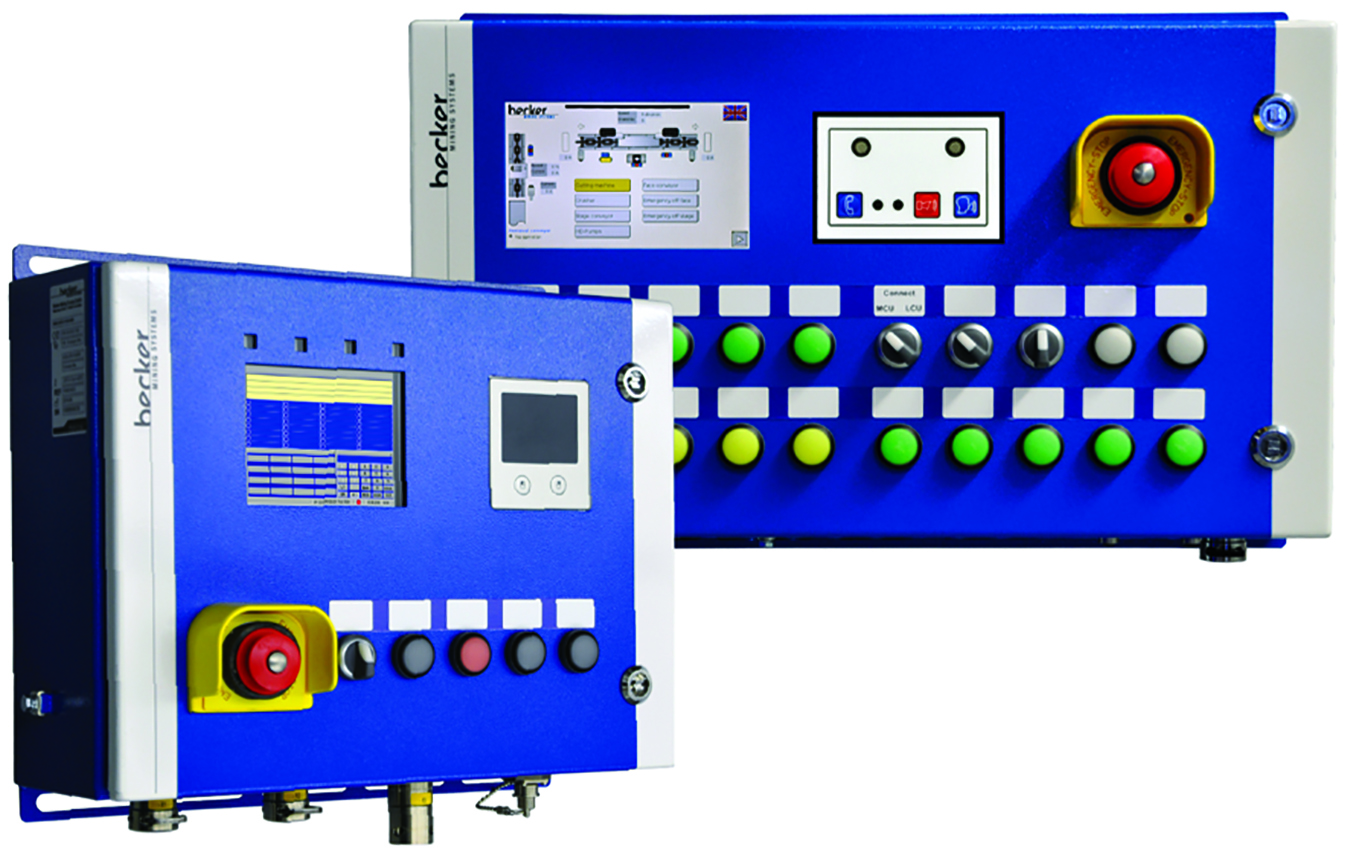
The PROMOS 4.0 automation system from Becker Mining will be available on the market later this year. (Photo: Becker Mining)
For underground haulage purposes, the company develops and manufactures market-leading rail technologies. The Minetrans monorail and floor-mounted trains present a smart modular kit, are well proven and sophisticated products. These track-bound solutions are also available electrically powered and showcase the latest technology and innovation.
Becker Mining Systems has subsidiaries and service centers in all major mining regions, so it is well equipped to provide prompt and comprehensive on-site engineering, product assistance and emergency services. The service centers conduct regular product training courses and customer tailored workshops. Not only do they provide user assistance, but they also share knowledge with, and learn from, mine operators, working together to determine future developments.
With more than 1,500 employees worldwide, the Becker Mining Systems Group of companies share their goal of constantly improving products, demonstrating leadership through technology and delivering superior customer service.
New Communication and Automation Solutions
The newly developed Smartcom WRAP260 series consists of intrinsically safe routers and switches for hazardous areas that can be operated with a battery-backup power supply. The WRAP260 models come with an IP67 rating and allow the continued operation of a safety-critical infrastructure even if the power supply fails.
The WRAP260 router is offered in different versions to meet different customer requirements. In the WRAP260, up to three combined routers in one housing can be used for large areas and guarantee a high data throughput even with many subscribers. The WRAP260.1 Double Router with two WiFi modules offers a cost-effective entry into a large WiFi infrastructure. In addition, the WRAP260.2 Triple Router with three WiFi modules enables the setup of a WiFi backbone and offers four Gbit fibre optic connections.
All router models are equipped with the robust BOS-CMKK connector system for fibre optic single mode lines (1 Gbit/s). The BOS-CMKK connector system is proven, easy to handle and IP68 certified. The cable length between two participants can be up to 20 km. All routers can be optioned with tagging and tracking functionality for RTLS systems.
Large amounts of data (video cameras, process data, voice information) require a powerful communication infrastructure in modern mines. The WRAP260.3 Single Switch is the ideal basis for this task. The WRAP260 variants Single Switch (5 Ports), Double Switch (10 Ports) and Gateway Switch (5×1 Gbit/s, 3×100 Mbit/s) cover all requirements.
The WRAP260.5 Gateway Switch is used to switch between existing devices with a data rate of 100 Mbit/s and newer devices with 1 Gbit/s data rate. It has 5 fibre single mode (1 Gbit/s) and 3 fibre single mode (100 Mbit/s) connectors. This system thus enables the construction of an underground data infrastructure in the combination of 100 Mbit/s and 1 Gbit/s in fibre optics.
The complete WRAP260 system is equipped with the powerful operating system Mikrotik Router OS. It offers extensive configuration possibilities (traffic shaping, firewall, VPN, QoS, RSTP for redundant structures) for the construction of a powerful infrastructure. All connections on the devices are pluggable to keep the installation as simple as possible. Local LED status indicators provide a convenient overview of the status of the devices. All devices can be conveniently remotely configured from above ground.
Furthermore, Becker Mining Systems’ new automation series, PROMOS 4.0, will be available on the market this year.
This offers a Fieldbus length of up to 4,000 m with 500-Kbit/s communication capability, digital speech transmission, intercoms with a volume of up to 110 dB for extreme ambient noise, rope pull emergency stop with rope breakage monitoring, and graphic visualization through a touch-screen display at an external control station.
During the development of these products, emphasis was placed on easy installation and maintenance. Bluetooth and RFID tracking are already planned and will be available in the near future.
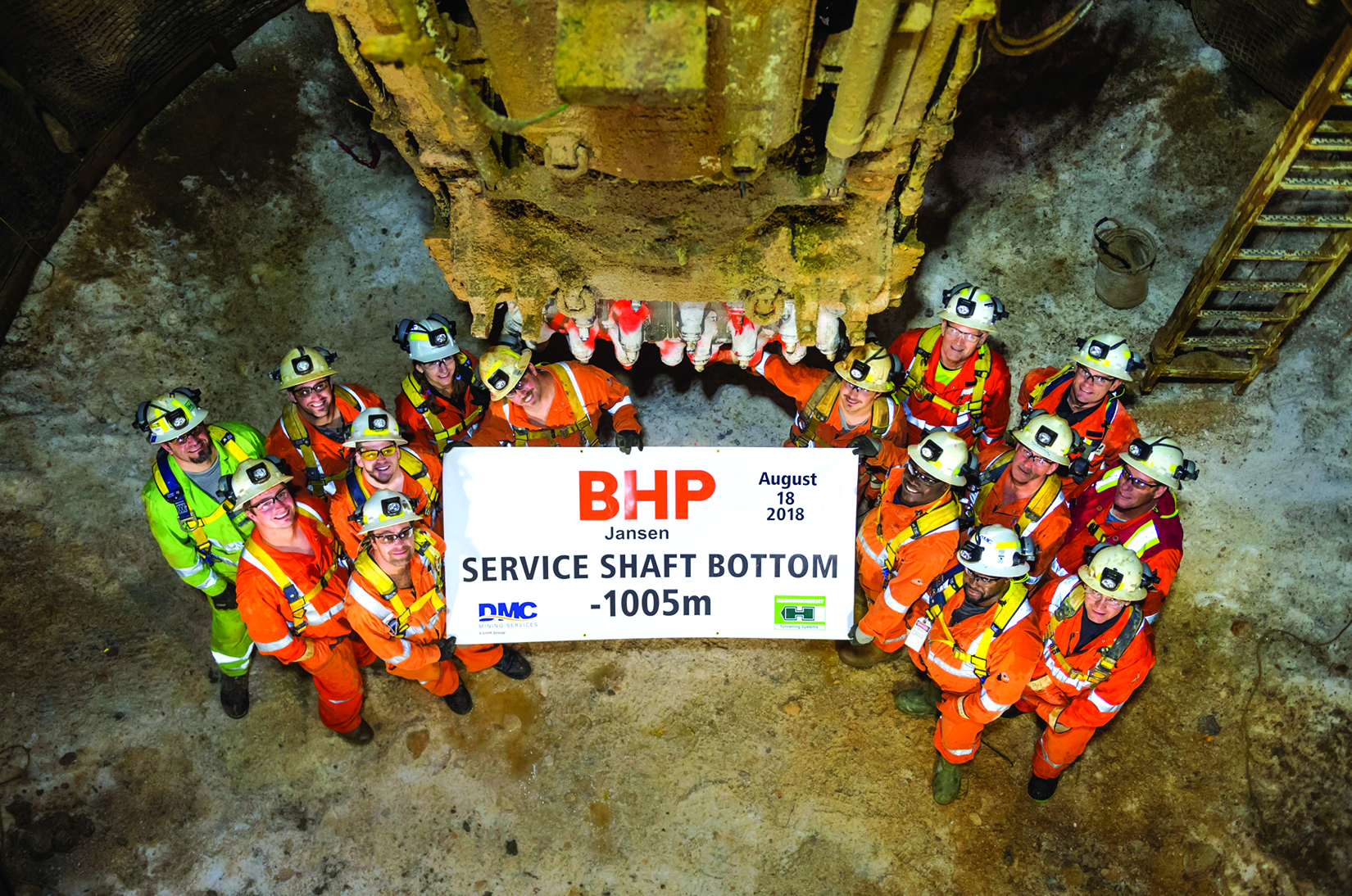
The Herrenknecht team poses at the bottom of the deepest Jansen shaft in 2018. (Photo: Herrenknecht)
Herrenknecht’s Mechanized Shaft Sinking Technology Proves Itself in Canada
Mining contractor DMC Mining Services used two Herrenknecht Shaft Boring Roadheaders (SBRs) to excavate two blind shafts, each with an approximate diameter of 8-11 meters (m) at BHP’s Jansen Potash project in Saskatchewan, Canada.
The project was successfully completed in August 2018, and Herrenknecht said the milestone is proof of the feasibility and advantages of the SBR concept for the mining industry.
The two blind shafts, which are intended as vertical access tunnels for the mine, were sunk to depths of -975 and -1,005 m respectively. The fully mechanized SBRs use a partial face-cutting method with a cutting drum mounted on a telescopic boom. The excavated rock was conveyed from the benches using a pneumatic mucking system (PNM) and transferred into muck buckets, which were hoisted to the surface. A special laser navigation system was designed for the project by Herrenknecht subsidiary, VMT GmbH. This used target units mounted on the SBR and lasers connected to the shaft wall to keep the machines on track.
Herrenknecht said it drew upon its knowledge and experience of mechanized tunnelling to develop the SBR. The machine is specifically designed for the mechanized sinking of blind shafts in soft- to medium-hard rock. It is based on the proven technology of the Herrenknecht Vertical Shaft Sinking Machine (VSM), and the company said it offers improved safety performance compared to conventional shaft sinking methods, while also achieving higher advance rates.
Herrenknecht described the geological conditions at Jansen as “anything but easy.” At around 450 m depth, the SBRs encountered a layer of extremely hard, competent rock, which caused excessive pick wear and low rates of advance. To overcome this and some further hardness challenges, the cutting drum was upgraded to a hard-rock drum and torque output was doubled.
Because an existing high-pressure underground waterway, known as the Blairmore aquifer, posed a risk of water ingress into the shaft, ground freezing was executed temporarily in 2011 by BHP to a depth of approximately 650 m.
The team also used a mechanical ring erector to install steel tubing segments through the Blairmore aquifer to minimize risk to personnel and to assist in the development of a composite steel and concrete watertight liner in both shafts.
Second Generation SBR Emerges
Since the project specification at Jansen required modifications to the SBRs, Herrenknecht, together with DMC Mining Services, “refined” the SBR technology during the project.
The result is the second-generation SBR, which is equipped with an additional stabilization level to allow the fixation of the SBR center pipe on both ends. Herrenknecht said this ensures stable transfer of the reactive forces from the cutting process to the shaft wall without movement of the machine — even with fluctuating excavation diameters from 8 m up to 11 m.
An improved filter system and a newly designed PNM system have also been installed to create a higher degree of separation in the suction tank, allowing wet material and even water to be handled.
“The technical development of the second SBR generation is based on the lessons learnt from the Jansen project,” Martin-Devid Herrenknecht, general manager for mining at Herrenknecht, explained. “Two SBRs of this generation are currently in operation in Belarus and are achieving good performance as a result of the improvements made. This pioneering approach is certainly a game changer for shaft sinking in soft- and medium-hard rock, impacting the whole mining industry.”
Following the successful excavation at Jansen, the two SBRs were disassembled in the shafts. To remove them, it was necessary to reduce the weight of the machines from 390 to 340 tonnes. This was achieved by stripping off all components that were in the excavation chamber. Both SBRs were safely recovered in May 2019.

Containerized ventilation equipment is a cost-effective solution for shaft sinking projects. (Photo: CFT)
CFT Supplies Innovative, Containerized Shaft Ventilation Systems
In 2018 and 2019, Gladbeck-based German company, CFT GmbH Compact Filter Technic, supplied custom-designed and built ventilation systems for shaft sinking projects at two potash mines: Slavkaliy’s Nezhinsky mine in Belarus and Sirius Mineral’s Woodsmith mine in northeast England. Both projects are currently under way using next-generation mechanized shaft sinking technologies.
The ventilation equipment destined for the Belarussian operation was supplied to contractor Redpath Deilmann GmbH of Dortmund, Germany (formerly Deilmann-Haniel GmbH), while the system intended for the U.K. project was delivered to DMC Mining Services (U.K.) Ltd. of Scarborough.
At both mines, containerized ventilation equipment was installed above ground to provide an adequate supply of fresh air during the sinking phase. CFT said this will ensure that both the sinking machines and the in-shaft workforce are able to operate in the best-possible conditions. The ventilation systems will therefore make a fundamental contribution to workplace health and safety and environmental protection, while at the same time promoting the efficiency and durability of the shaft sinking machines.
CFT said the mobile containers have proven to be a cost-effective solution for shaft sinking projects, and their flexibility and reusability can open new application options. For example, if the equipment must be redeployed to another site, the ability to rapidly dismantle and reassemble the system helps operators to adhere to tight time schedules.
Containers are also easy to transport and can readily be placed in interim storage. The system is made even more efficient by the elimination of individual enclosures for each of the components, while containerization also meets the highest demands when it comes to acoustic insulation.

